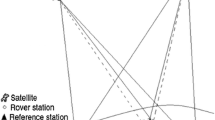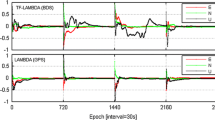Abstract
BeiDou navigation satellite system transmits triple-frequency signals. This paper reviews the disadvantages of the traditional least-squares ambiguity decorrelation adjustment algorithm in the ambiguity resolution and exploits the advantages of triple-frequency BDS. A new ambiguity resolution method that is based on adaptive ionosphere estimation constraints for medium-length baselines (from 50 to 100 km) is proposed. We realize the method in two steps. First, double-differencing uncombined observables (B1/B2/B3 observables) are used to obtain float solutions with atmospheric delay estimated as a random walk parameter by using the extended Kalman filter. Second, two ambiguity search equations are constructed between any two uncombined ambiguities. The adaptively estimated ionospheric delay shown in step one is also used to constrain ambiguity search equations. Finally, traversal search of integer ambiguity is performed. The method is decreasingly affected by the cycle slips and reference satellite switching, which can effectively avoid the unstable positioning accuracy of the carrier in the RTK positioning of medium-length baselines. In this study, BDS triple-frequency data collected from two baselines of 53 km and 103 km, respectively, are used to validate the proposed method. Experiments show that the medium-length baseline ambiguity can be rapidly fixed within one single epoch. Although the baseline is over 100 km, the accuracy of coordinate component under dynamic conditions can reach the centimeter level.












Similar content being viewed by others
References
Alves P., (2001). The effect of galileo on carrier phase ambiguity resolution
Boehm, J., Niell, A., Tregoning, P., & Schuh, H. (2006). Global mapping function (GMF): a new empirical mapping function based on numerical weather model data. Geophysical Research Letters. https://doi.org/10.1029/2005GL025546
Brack, A. (2015). On reliable data-driven partial GNSS ambiguity resolution [J]. GPS Solutions, 19(3), 411–422
Buist, P. J., Teunissen, P. J. G., Verhagen, S., et al. (2011). A vectorial bootstrapping approach for integrated GNSS-based relative positioning and attitude determination of spacecraft [J]. Acta Astronautica., 68(7–8), 1113–1125
Cao, J.J., Fang, J.C., Wei S., (2008) GFMIMU/GPS integrated navigation system data fusion. Journal of System Simulation.
Causa, F., Renga, A., Grassi, M., 2017. Ionosphere-gradient based filtering approach for precise relative navigation in LEO [C]// IEEE International Workshop on Metrology for Aerospace. IEEE.
Chu, F. Y., & Yang, M. (2014). GPS/Galileo long baseline computation: method and performance analysis. GPS Solutions, 18(2), 263–272
Cui, J., Tang, W., J in, L., , et al. (2018). An improved ionosphere interpolation algorithm for network RTK in low-latitude regions [J]. GPS Solutions, 22(4), 109
Dai, L., Wang, J., Rizos, C., et al. (2003). Predicting Atmospheric Biases for Real-Time Ambiguity Resolution in GPS/GLONASS Reference Station Networks[J]. Journal of Geodesy, 76, 617–628
Deng, J., Wang, S., & Chen, R. (2016). Real-time dynamic ambiguity resolution strategy for GNSS networks [J]. China Journal of Inertial Technology., 24(1), 14–19
Feng, Y. (2008a). GNSS three carrier ambiguity resolution using ionosphere-reduced virtual signals. Journal of Geodesy, 82(12), 847–862
Feng, Y., Rizos, C., 2005. Three carrier approaches for future global regional and local GNSS positioning services: concepts and performance Perspectives. Proceedings of ION GNSS 2005, 13–16 September, Long Beach, CA, pp. 2277–2787.
Feng, Y. M. (2008b). GNSS three carrier ambiguity resolution using ionosphere -reduced virtual signals. Journal of Geodesy, 82, 847–862
Feng, Y. M., & Li, B. F. (2008). A benefit of multiple carrier GNSS signals: Reglobal scale network-based RTK with doubled inter-station distances. J. Spatial Sci., 53, 135–147
Forssell, B., Martinneira, M., Harrisz, R.A., (1997). Carrier phase ambiguity resolution In Gnss-2[J]. Proceedings of Ion Gps, pp. 1727–1736.
Gao, Z., Ge, M., Shen, W., et al. (2017). Ionospheric and receiver DCB-constrained multi-GNSS single-frequency PPP integrated with MEMS inertial measurements [J]. Journal of Geodesy, 91(11), 1351–1366
Ji, M., Murata, T., Takiguchi, J.I. et al. (2008). GPS accuracy improvement by satellite selection using omnidirectional infrared camera[C]. IEEE/RSJ International Conference on Intelligent Robots & Systems. IEEE
Jung, J., 1999. High integrity carrier phase navigation for future LAAS using multiple civilian GPS signals. Proc. ION GPS-1999, Institute of Navigation, Nashville, Tennessee, Alexandria, pp. 14–17.
Julien O., (2003). A tightly coupled GPS/GALILEO combination for improved ambiguity resolution
Kang, Ronglei., 2009. Research on uncertainty mathematics theory in the precise positioning of GNSS [D]. University of electronic science and technology.
Kashani, I., Grejner-Brzezinska, D., Wielgosz, P., et al. (2005). Toward instantaneous network-based real-time kinematic GPS over 100 km distance [J]. Navigation, 52(4), 239–245
Kim, D., Langley, R.B., (2005). Nullification of differential ionospheric delay for long-baseline real-time kinematic applications. In: Proceedings of ION 61st Annual Meeting, Cambridge, Massachusetts, 27-29 June 2005, pp. 949-960
Lou, Y., Gong, X., Gu, S., Zheng, F., & Feng, Y. (2016). Assessment of code bias variations of BDS triple-frequency signals and their impacts on ambiguity resolution for long baselines. GPS Solutions. https://doi.org/10.1007/s10291-016-0514-4
Man, X., Sun, F., Ye, D., et al. (2017). A new fast solution method for triple-frequency ambiguity of medium and long distance GNSS [J]. Geodesy and Geodynamics., 37(4), 374–379
Odijk, D., 2000. Weighting ionospheric corrections to improve fast GPS positioning over medium distances. Proceedings of the ION GPS, 19–22 September, Salt Lake City, UT, pp. 1113–1123.
Odijk, D., & Teunissen, P. J. G. (2008). ADOP in closed form for a hierarchy of multi-frequency single-baseline GNSS models. Journal of Geodesy, 82, 473–492
Paziewski, J. (2015). Study on desirable ionosphere corrections accuracy for network-RTK positioning and its impact on time-to-fix and probability of successful single-epoch ambiguity resolution. Advances in Space Research, 57(4), 1098–1111
Sun, Hongxing., Li, Deren., 2003. Solving GPS integer ambiguity using single epoch of triple-frequency correlation method [J]. Journal of Surveying and Mapping. 32 (3).
Teunissen, P. (1995). The least-squares ambiguity decorrelation adjustment a method for fast GPS integer ambiguity estimation. Journal of Geodesy, 70(1), 65–82
Teunissen, P., Joosten, P., Tiberius, C., 2002. A comparison of TCAR, CIR and LAMBDA GNSS ambiguity resolution. Proceedings of the ION GPS, 24–27 September, Portland, OR, pp. 2799–2808.
Tian, Y., Hao, J., Yu, H., et al. (2016). Improved ionosphere model algorithms for LEO satellite single-frequency precise orbit determination [J]. Acta Geodaetica Et Cartographica Sinica., 45(7), 803–809
Tunissen, P. (1997). The geometry-free GPS ambiguity search space with a weighted ionosphere. Journal of Geodesy, 71(6), 370–383
Verhagen, S., Teunissen, P., Odijk, D., (2007). Carrier-phase ambiguity success rates for integrated GPS-Galileo satellite navigation. IEICE Technical Report
Wang, G., Meng, X., Gao, C., et al. (2018). Combined GPS and BDS for single-frequency continuous RTK positioning through real-time estimation of differential inter-system biases [J]. GPS Solutions, 22(1), 20
Wu, M., He, J., & Wang, H. (2016). Single epoch reliable fixing of ambiguity in Beidou triple-frequency precision attitude measurement [J]. Chinese Journal of Inertial Technology., 24(05), 70–78
Wu, Z., Bian, S., Xiang, C., et al. (2015). A GNSS ambiguity resolution method based on partial search [J]. Journal of Naval Engineering University., 1, 31–34
Xu, Y., Ji, S., Chen, W., & Weng, D. (2015). A new ionosphere-free ambiguity resolution method for long-range baseline with GNSS triple-frequency signals. Advances in Space Research, 56(8), 1600–1612
Yang, Rengui., Ou, Jikun., 2005. A new method to improve the success rate of GPS single-frequency phase ambiguity resolution [J]. Journal of Nanjing University of Aeronautics and Astronautics. 37 (3).
Yao, Y., Gao, J., Li, Z., et al. (2016). Single epoch baseline resolution of Beidou triple frequency carrier based on ambiguity correlation method [J]. Journal of Wuhan University, Information Science Edition., 41(11), 1433–1439
Zang, N., Li, B., & Shen, Y. (2017). Comparison and analysis of three PPP models of GPS+BDS combination [J]. Journal of Surveying and Mapping., 46(12), 1929–1938
Zhou, Feng., 2018. Research on the theory and method of non-difference and non-combination precise single point positioning for multi-system GNSS [D]. East China Normal University.
Zhu, H., Liu, J., Tang, W., & Gao, X. (2012). RTK reference station double-differencing ambiguity fast algorithm [J]. Journal of Wuhan University, Information Science Edition., 37(6), 688–692
Author information
Authors and Affiliations
Corresponding author
Ethics declarations
Conflict of interest
The authors declare that they have no conflict of interest.
Additional information
Publisher's Note
Springer Nature remains neutral with regard to jurisdictional claims in published maps and institutional affiliations.
About this article
Cite this article
Yang, G., Wang, Q., Zhou, S. et al. A New AR Method Using BDS Triple-Frequency Observation. J Indian Soc Remote Sens 49, 2199–2213 (2021). https://doi.org/10.1007/s12524-021-01378-7
Received:
Accepted:
Published:
Issue Date:
DOI: https://doi.org/10.1007/s12524-021-01378-7




